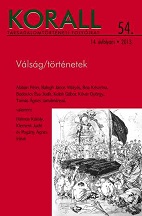Demográfiai válság az Ormánságban. Családrekonstitúciós eredmények a vajszlói anyakönyvi kerületből
Demographic Crisis in the Ormánság Region. Family Reconstitution in the Vajszló Registry District
Author(s): Gábor KolohSubject(s): History
Published by: KORALL Társadalomtörténeti Egyesület
Summary/Abstract: The study is a preliminary report of a research project on the one-child family system that became prevalent in the Ormánság region of Hungary as a result of family planning becoming increasingly wide-spread in the inter-war years. This most telling evidence for the widening practice of family planning is analysed from a number of angles and placed in the context of the period’s social processes. The study is not wholly without previous foundations; preceding studies helped make this subject one of the most frequently studied questions of Hungarian historical demography. For example, this present research project also builds on the conclusions of Rudolf Andorka’s work on the subject. The project picks up where Andorka left off and it covers the period from 1895 onwards, primarily based on public records providing data about heterogeneous social groups. The one-child policy of Ormánság families was one of the most important questions and the centre of attention in the so-called ‘one-child discourse’ between the world wars. Koloh’s new study juxtaposes some of the statements of this discourse with actual demographic statistics from the region. The figures in the report are based on family reconstitution, which is one of the most valuable tools for this nominative analysis. It is important to stress that the report is preliminary, because calculating the age-specific fertility rate and the average birth intervals of women having children in the Vajszló registry district has been completed for only 111 families so far. The paper also entails an analysis of the distribution by number of children, concluding that the single-child strategy was a decision based on a new kind of appreciation of children rather than the result of financial considerations.
Journal: Korall - Társadalomtörténeti folyóirat
- Issue Year: 2013
- Issue No: 54
- Page Range: 104-117
- Page Count: 14
- Language: Hungarian

